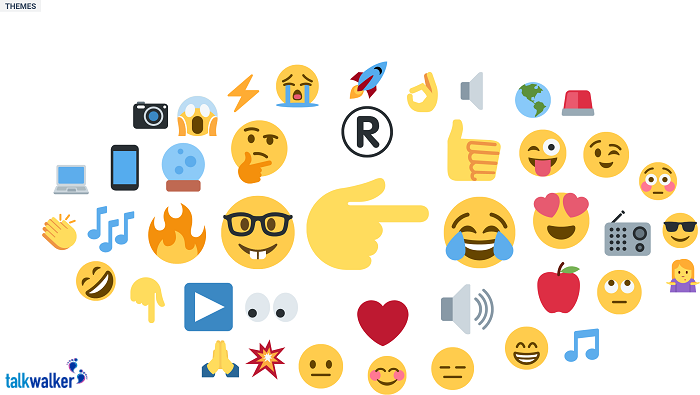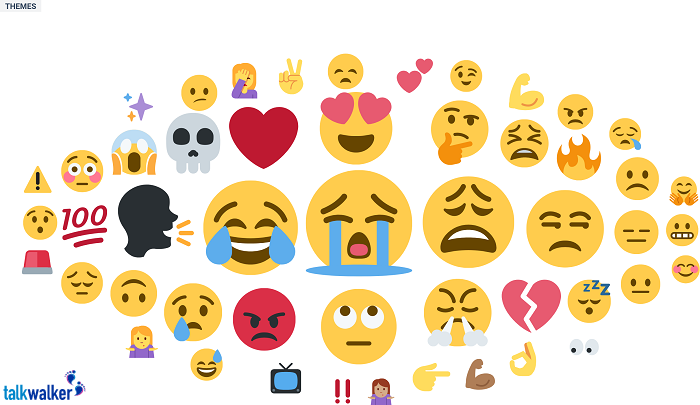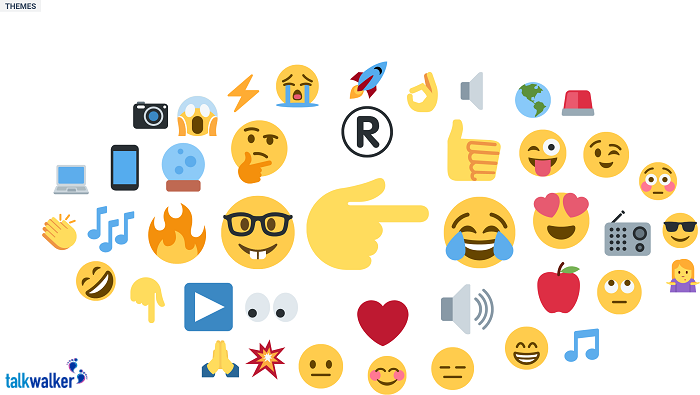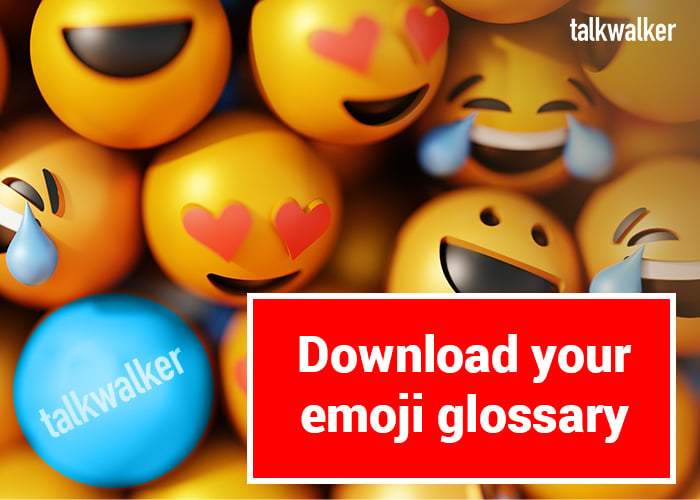Why is emoji analysis important?
Emojis are everywhere. They’re on T-shirts, mugs, and keyrings. Even having their own movie.
In 2015, 92% of the online community used emojis in their conversations. And that number is growing. We detected 13% more posts containing emojis in March 2018 than March 2017.
Emojis are a part of your consumers’ language, and it's essential for you to understand your brand's emoji meanings fully to understand what consumers are saying.
Take this tweet, for example...
oh, happy #NationalGirlfriendsDay btw ..
— Colby (@ColbyBrock) August 1, 2017
At first, you’d think this was a positive, celebratory tweet. But the addition of the emoji twists the meaning into something bitter and disappointed.
Using emoji analysis, you will get a better understanding of what consumers are really saying, whether that’s about a topic, a trend, or your brand.
Just take a look at what we discovered by doing emoji analysis of Trump's first 100 days.
The history of emojis
To understand emojis, it’s worth knowing a little about their history.
They originated as ‘emoticons’ in 1982 when Scott Fahlman used :-) to help explain when something was a joke.
Their popularity grew in the 90s and 2000s due to the character restrictions of text messaging (160) and Twitter (180), as they added useful emotional context in limited space.
As technology developed, they became pictorial, rather than text-based, with Shigetaka Kurita leading the way.
Finally, in October 2010, the modern emojis were incorporated into Unicode 6.0, offering a consistent standard used across all systems and devices.
As of the 2017 Unicode 10, there are now 2,666 emojis available, with an extra 157 due in 2018.
What you can do with emoji analysis
Brand interaction and buyer intent
Emojis are also useful to get a quick overview of your consumers’ perceptions of your brand, and what they associate with it.
Our emoji cloud gives you an overview of the emojis related to the Apple HomePod.

Emoji analysis = quite positive, with lots of happy emojis (❤️) associated with the brand.
It’s interesting that the second most used emoji was . It seems that people think that the HomePod is a particularly geeky object. It would be worthwhile for Apple to break that preconception if the HomePod is to become more mainstream and less niche.
The thinking face () is beneficial to look out for, often used in association with people considering their buying options. It could indicate that they’re comparing the product to a competitor (in this case the Google Home or Amazon Echo).
By monitoring mentions of this emoji with your brand, you can engage with consumers looking to buy, and nudge them in the right direction.
Just think what could have happened here if Apple, Amazon or Google had engaged this tweet with an offer...
I’m thinking of getting a HomePod
— AxsisRosales (@AlexisPkGarcia) February 15, 2018
Find hidden mentions
When considering the topic you're searching for, think about searching for emojis, too.
In the last 13 months, there were 70.2 million mentions of pizza. But the emoji (without any mentions of the keyword pizza) had an extra 13.3 million mentions.
By using the search “pizza OR ” as your topic, you would find an extra 18.9% mentions around pizza.
Not only do the number of mentions change, but the conversation does, too. For just pizza mentions, the most mentioned brands are Pizza Hut, Papa John’s and Domino’s, with Papa John’s receiving 12.4% more mentions than Domino’s.
But when you monitor mentions of pizza OR , the order stays the same, but this time Papa John’s only has 10.7% more mentions.
It may only seem a small change, but if you’re measuring pizza consumer trends on a global scale, it matters. It also means Papa John’s consumers engage with the emoji more than those of Domino’s, so Papa John should use it more to boost brand engagement (see later on).
Just had my first Papa John's.
Unbelievable!
— Kurtis Norman (@KurtisNorman_) July 8, 2017
Brand association
Another emoji analysis technique is to look at what brands consumers associate with specific emojis. This gives you a picture of your consumers’ top of mind.
It’s like one big Rorschach test. If the wider population associate a specific brand with certain emojis, it demonstrates how well that brand has diffused into the consumer psyche.
McDonald’s will be pleased to know both and , are more often associated with their brand than competitors like Burger King.
BMW is the brand most linked to .
The Philadelphia Eagles are the most common team related to .
If you want to see where your brand sits in people’s top of mind, look for the most common emojis associated with your brand, then look for where your brand ranks for those emojis.
McDonald’s know how highly people associate the burger emoji with their brand.
McDonald's knows how to have good times #advertising #creative #marketing #printads #havegoodtimes #goodtimes #mcdonalds pic.twitter.com/mCnvoi5UAO
— Ad World Masters (@adworldmasters) March 19, 2018
Add extra insights to your sentiment analysis
Sentiment analysis is an additional process that helps you understand your brand mentions, by defining whether they are positive, negative, or neutral. That way, you get a better understanding of your brand perception.
The algorithm that Talkwalker uses to categorize sentiment, measures a variety of factors from posts, like the global context and emoji usage.
But you can use emoji analysis to add extra context to that sentiment.
In the last 13 months, Netflix received over 15 million negative mentions (around 19% overall).
But that only highlights them as negative, without any emotional context. By looking at the emojis included in those mentions, we can get a better idea what negative emotion is driving those conversations.

The sad emoji often relates to either an emotional ending or incident in a show, or to a popular series being taken off Netflix. Both are worth monitoring to see which show their consumers are engaging with.
All I want to do is watch One Tree Hill why did Netflix remove it
— Hunter Wolfe (@hunterdestin) December 31, 2017
The angry emoji came up in some similar contexts but was also used regularly with mentions of technical issues or people impersonating other people’s accounts.
Whichever BROKE weirdo thinks it’s okay to keep using my Netflix ITS NOT it’s literally £6 a month
— elese (@EleseKilgariff) January 5, 2018
Though not in the top 50 emojis, three of the ones related to sickness () were linked to numerous mentions. These were due to people choosing Netflix when sick. It appears “Netflix and ill” is a trend.
Emoji analysis gives you an extra level of depth to your sentiment analysis.
Trend analysis for brand engagement
Another use of emoji analysis is for seeing what conversations your audience is engaging with. This is useful for boosting your brand engagement.
Say you want to engage with vegetarians more. One of the most commonly used emojis in conversations around vegetarian or vegetarianism is the green heart .
That’s because the is often used in conversations around healthy eating, environmental awareness, and alternative diets. If you want to engage with that market, you need to monitor the emoji, and ensure it’s used in your conversations.
We dump a garbage truck full of plastic into the ocean every MINUTE and it's expected to double by 2030. By 2050 there will be more plastic than fish in our oceans. Please reduce your use of plastic. ♻️ The Earth will thank you. Here are a few every day tips:
— Honey (@soyamacchiato) February 26, 2018
More emoji analysis options
These are just a few examples of what you can do with emoji analysis. After all, there’re 2,666, so there’re still plenty more for interpretation. And as the number grows, more opportunities open for you to claim one for your own.
To get a better overview of all the emojis your consumers are using (and so much more), download our free Emoji Glossary below. And don’t forget to leave a comment.





